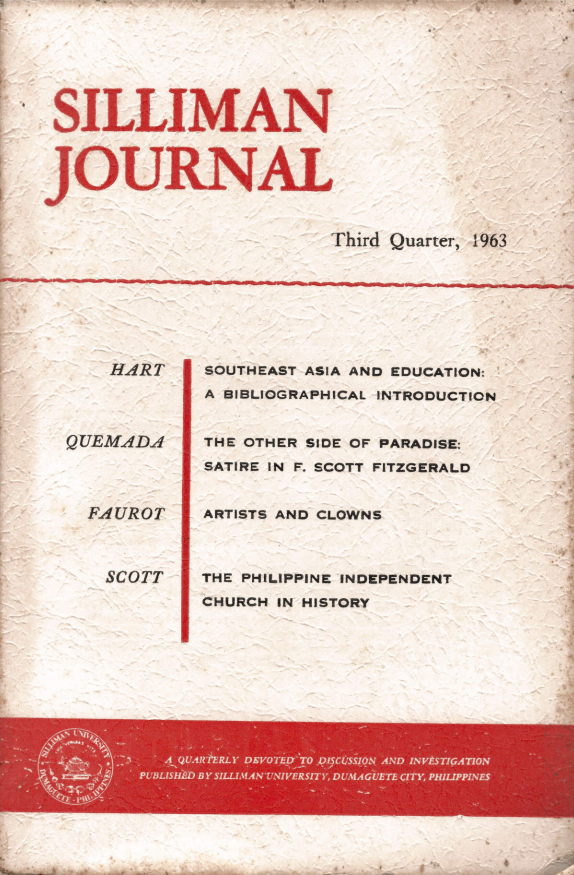Archives - Page 4
-

Silliman Journal
Vol. 37 No. 2 (1994)Like the issue that preceded this, this issue of Silliman Journal is another slim volume containing areas of general interest. The three main studies here represent diverse topics--conservation of an endangered species, experimental propagation of a marine gastropod and observance of an indigenous religious ritual.
The lead article is Alcala's comprehensive report on the successful implementation of the Spotted Deer Captive Breeding Project of Silliman University as part of the overall conservation effort for this endangered species. Considered by peers as a "major contribution" the article discusses aspects of veterinary care and management of the Cervus alfredi developed since 1990 when the country's first spotted deer captive breeding facility was set up at Silliman.
A special feature in this particular issue is the inaugural speech of Dr. Mervyn J. Misajon whose installation as tenth president of Silliman University highlight the University's 93rd Founders Day celebration.
Also included in this collection are three lectures, two which were part of the 93rd Founders Day lecture series
-

Silliman Journal
Vol. 28 No. 3 & 4 (1981)In this issue we are pleased to continue the studies of Philippine history that have recently been a feature of SJ. In fact, both of our historical offerings have roots in earlier issues of this journal. William
Henry Scott, editor of “The Republic of Candon” by Fernando Guirnalda (SJ 26 [1979]) here fleshes out that first-hand revolutionary account with his own historical analysis. In doing so, he provides a
strong case for the elevation of Isabelo Abaya to the pantheon of heroes of the Philippine Revolution.F. Delor Angeles, treating an earlier period of Philippine history, succeeds in doing what one might think impossible, that is, painting a somewhat favorable picture of the Spanish Inquisition! Again, his
comments on eighteenth-century Armenian immigration to the Philippines grow out of his earlier presentation of “Bibliographical Data” on the Inquisition in the Spanish Philippines (SJ 23 [1976]).As a number of articles in SJ have pointed out, the Lake Balinsasayao area is beautiful, biologically and economically important, and in great danger. Lawrence Heaney, Paul Heideman, and Karen Mudar
provide us with information on the mammals of the area and remind us of what must be done if they are to survive.A bit of welcome controversy is injected into this issue through the contribution of Rowe Cadelifia. Cadelifia’s vision for Philippine anthropology is of a discipline that allows a sensitivity to questions of
equity to temper its scientific detachment. Cadelifia pleads not only for description but also for prescription. We would welcome responses #rom readers to his suggestion that the anthropologist should be an agent of change.Both Hileconida Calumpong and Paul Palmore lend practical notes to this issue of SJ, falling into the company of previous authors who have listed herbal medicines (Maturan, SJ 27 [1980]) and provided
instructions for raising fish in a floating cage (Carumbana and Luchavez, SJ 26 [1979]) or encouraging their growth by building an artificial reef (Bernard, SJ 26 [1979]). Readers of the Silliman Journal should
expect more articles of this sort. -

Silliman Journal
Vol. 11 No. 4 (1964)Occasionally the Silliman Journal is pleased to devote an entire
quarter to some lengthy, specialized study. This quarter we are
privileged to present in full the important paper on “Theories of the
Introduction and Expansion of Islam in Malaysia” prepared by Dr.
Cezar Adib Majul and read before the Second International Confer-
ence of Historians of Asia which met at Taipeh, Taiwan in August
of 1962. The paper was printed originally in the Proceedings of the
Conference and js reprinted here with permission. :A Filipino of Lebanese ancestry, Dr. Majul is Dean of the Uni-
versity College, University of the Philippines, and is widely known
as one of the foremost historians and political scientists of Asia. He
holds the Ph.D. degree in Political Science from Cornell University
and is the author of three scholarly books having to do with the
Philippine Revolution and one of its theorists: The Political and Con-
stitutional Ideas of the Philippine Revolution; Mabini and the Phil-
ippine Revolution; and Apolinario Mabini: Revolutionary.Partly because of his own Muslim background, Dean Majul has
long had an interest in the history and spread of Islam in this part
of the world and has travelled extensively and read widely in the
the field. He has heen privileged to examine the precious tarsilas
(genealogies) of some of the Tau Sug families in Sulu, a privilege
rarely granted to outsiders. Study of these farsilas is essential to
competent scholarship concerning the history of Islam in the Philip-
pines. The paper here presented is one of the first fruits of Dean
Majul’s studies in Malaysian Islam and there are many more such
studies to follow in the years ahead. He brings to his work in this
field the same scholarly craftsmanship that he has shown in his
studies of the Philippine revolution and Apolinario Mabini. Not since
Dr. Najeeb Saleeby (who was, incidentally, a compatriot and warm
friend of his father) has a scholar with the interest and competence
of Dean Majul brought his skill to bear on the study of Islam in the
Malay world and particularly the Philippine portion of it.Peter G. Gowing
-

Silliman Journal
Vol. 10 No. 4 (1963)A small, informal conference of veteran U. S. Peace Corps
Volunteers at Pendle Hill, Pennsylvania, in December of this year
provided the main source for the illuminating article by Lawrence
Howard and Paul Hare. In 1961-63, the Philippines saw the largest
single concentration of Peace Corps Volunteers—and more than half
of the returnees present at the conference were from the Philippine
Project.We are pleased to republish another fine article by Mr. William
Henry Scott. Though not professionally an anthropologist, Mr. Scott
has earned a well-deserved reputation as an authority on the life
and culture of Mountain Province, particularly in the Bontoe area.
His article “Boyhood in Sagada” is reprinted with permission from
the July 1958 issue of Anthropological Quarterly.My “Scripture and Tradition: Trends in Protestant Theology
Teday” is a slightly expanded (to include the July Montreal Faith and
Order discussions) version of a paper prepared for the Annual Meet-
ing of the Philippine Theological Society which met at St. Andrew’s
Theological Seminary in Quezon City in May of this year. Father H.
Ellsworth Chandlee, of the St. Andrew’s faculty, substantially ex-
panded on the theme of the paper and it is a privilege to publish his
comments in these pages.The Silliman Journal.sees itself as a “Quarterly devoted to dis-
cussion and investigation in the humanities and the sciences”. Just
how well the Jowrnal has lived up to that image of itself can be seen
in the Decennial Index painstakingly prepared by Mr. Eliseo P.
Bafias of the Library staff. We are grateful to Mr. Bafias for this
service which should prove a real boon to scholars in locating the
valuable studies published in the first decade of the Journal’s exis-
tence.‘We would like to have presented a bound set of ten volumes of
the Silliman Journal to Dr. James W. Chapman, long-time distin-
guished member of the University faculty. whose name honors the
Research Foundation which has helped finance the Journal for the
past ten years. Unfortunately, Dr. Chapman, who with Mrs. Chap-
man retired from Silliman in 1950, was accidentally killed near his
home in SaneMateo, California, in February of 1964, before this issue
went to press.PETER G. GOWING
-

Silliman Journal
Vol. 10 No. 3 (1963)Scholars will understand the importance of bibliographical stu-
dies and Professor Donn V. Hart’s bibliographical writings on South-
east Asia and the Philippines have been universally well received.
We are indeed happy to make available the very valuable bibliogra-
phy he has prepared on education in Southeast Asia. Dr. Hart, an
anthropologist, has lived in the Philippines, studying and partici-
pating in barrio life, and his monographs, embodying his findings,
have provided significant contributions to our growing understand-
ing of the culture characteristics of this land.Occasionally the Journal republishes important Filipiniana ma-
terial printed previously in periodicals which do not circulate widely,
or at all, in the Philippines. Such is the case with Mr. William
Henry Scott’s piece on “The Philippine Independent Church in His-
tory:” which appeared originally in the Hast and West Review for
January, 1962. It is reprinted here with permission. We shall read
more of Mr. Scott’s material in future issues, for some of his ex-
ceedingly useful anthropological studies of Mountain Province, pub-
lished elsewhere, deserve larger readership.Bishop John A. T. Robinscn’s book, Honest To God, has stirred
considerable discussion, much of it heated, in both England and
America. Professor Douglas J. Elwood’s provocative review helps to
clue us in on the debate which doubtless will have its reverberations
throughout the Christian world.It is with deep regret that I announce the sudden death of Mr.
Job. R. Villagonzalo, our Editorial Assistant, on May 30, 1964, as
this issue was in the press. For a number of years he has, in addi-
tion to his other duties in the president’s office, undertaken the job
of proofreading the galleys of the Journal, a tedious task he perform-
ed with great skill.PETER G. GOWING
-

Silliman Journal
Vol. 10 No. 1 (1963)Opinions and facts in articles published in the Silliman Journal are the sole responsibility of the individual author and not of the Editor, the Editorial Board or Silliman University.
Silliman Journal is published quarterly in March, June and September and December by Silliman University under the auspices of the James W. Champan Research Foundation, Dumaguete City, Philippines. Subscription in the Philippines, ₱8.00 a year, ₱2.25 per copy; U.S. and foreign countries, US$5.00 a year, US$1.00 per copy. Entered as second class mail matter at the Dumaguete City Post Office on September 1, 1954.
-

Silliman Journal
Vol. 9 No. 2 (1962)Silliman Journal is published quarterly in March, June, September, and December by Silliman University under the auspices of the James W. Chapman Research Foundation, Dumaguete City, Philippines. Subscription in the Philippines, P8.00 a year, P2.25 per copy; U.S. and foreign countries, US$5.00 a year, US$1.50 per copy. Entered as second class mail matter at the Dumaguete City Post Office on September 1, 1954.

